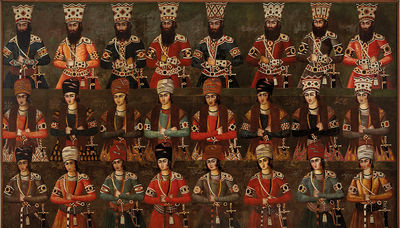Christie’s next sale of Art of the Islamic and Indian Worlds, which takes place on 1 April 2021, will be led by a recently rediscovered Qajar painting of the utmost importance.
The monumental painting to be offered at Christie’s dates from the early 19th century. It is the largest of its kind ever to appear at auction, measuring 101 x 174 inches, and will be offered with an estimate of GB Pounds 1,000,000-1,500,000.
Only one other fragment of a similar painting has come under the hammer. That was slightly smaller and sold at auction in 1975.
Qajar art is recognizable for its distinctive style of portraiture, and the present work includes a total of 24 portraits of dignitaries and princes at a Persian New Year celebration, during the so-called Saf-eSalam or ‘greetings queue’.
Represented are sons, sons-in-law, and grandsons of Fath ‘Ali Shah (1722- 1834), the second ruler of the Qajar dynasty. They are painted standing in three ranks of eight according to age. Each is depicted at three-quarter length with their arms folded, in full court dress with profusely jeweled crowns, belts, swords, and armbands wearing costumes of red, tan, blue, black,and gray.
The painting, depicting a Persian New Year, Norouz, procession, was bought by the artist and collector Frederic Clay Bartlett (1873-1953) in the early 1920s in the US, to be hung in his studio at the family’s winter retreat “Bonnet House” in Fort Lauderdale, Florida.

Abdallah Khan and his assistants painted it in an unknown palace shortly after 1810. The main image of the Shah (probably surrounded by his eldest sons) has been lost, though panels from the left- and right-hand walls came to the art market in 1973 and 1975 respectively. The former is now part of a private collection, the latter owned by the Saadabad Museum in Tehran.

